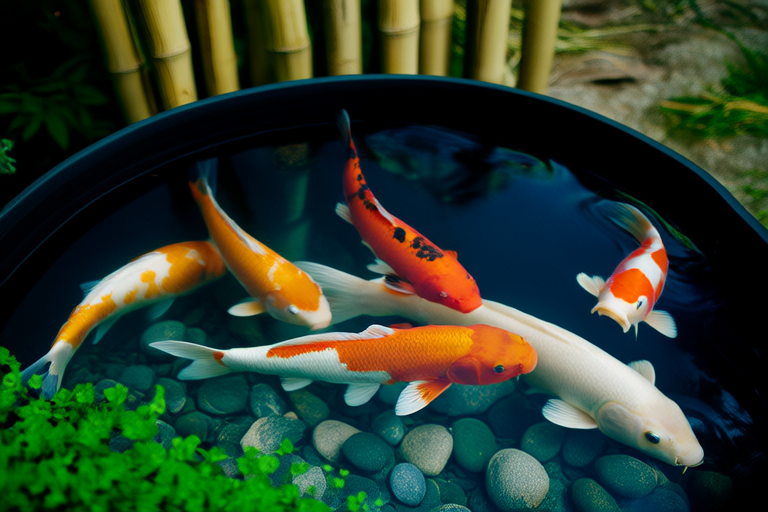How to Create the Perfect Habitat for Happy, Healthy Koi
Selecting the Right Pond Size and Shape
The first step in creating a perfect habitat for your koi is choosing the right pond size and shape. The pond should be large enough to accommodate the number of koi you plan to keep, with a minimum depth of 3 feet (91 cm) to provide a stable environment that is less affected by temperature fluctuations. A deeper pond will also allow for better oxygen circulation and prevent freezing in colder climates.
When it comes to shape, irregular shapes are preferable as they create more surface area and hiding spots for your koi. Additionally, consider incorporating ledges or shelves at different depths within the pond to provide varied environments for your fish. This not only adds aesthetic value but also enhances the overall health of your koi by giving them places to rest and explore.
Optimal Water Quality Maintenance
Maintaining optimal water quality is crucial for the health of your koi. Regular testing of the water parameters such as ammonia, nitrite, pH, and hardness ensures that any potential issues can be addressed promptly. Ammonia and nitrite levels should be kept at zero, while maintaining a pH between 7.2 and 8.5 is ideal for most koi species. Hardness levels should be around 100-250 ppm.
To achieve these conditions, regular partial water changes are essential. Aim for a 10% weekly water change during warm months when biological activity increases, reducing this to 5% during cooler periods. Use a dechlorinator if your tap water contains chlorine or chloramines to protect the beneficial bacteria in your filter system.
Necessary Filtration Systems
A robust filtration system is vital for removing waste, excess food, and other debris from the water, ensuring clear and healthy living conditions for your koi. There are several types of filters available, including mechanical, biological, and chemical filters.
- Mechanical Filters: These remove larger particles like leaves and uneaten food from the water. They typically consist of skimmers or pre-filters.
- Biological Filters: Housing beneficial bacteria that convert harmful ammonia into less toxic compounds, these filters are crucial for maintaining stable water chemistry.
- Chemical Filters: Using activated carbon or other media to absorb dissolved organic compounds and colorants, these filters help maintain crystal-clear water.
Choose a filter based on your pond’s volume and the number of koi you intend to keep. Ensure adequate flow rates through the filter to maintain efficient operation. Properly sized and maintained filters will significantly reduce the workload required to keep your pond clean and balanced.
Ideal Temperature and pH Levels
Koi prefer water temperatures ranging from 64°F to 82°F (18°C to 28°C). During warmer months, shading parts of the pond can help regulate temperature, preventing overheating which could stress your fish. Conversely, in colder climates, consider installing a heater to maintain a consistent temperature above 60°F (15°C).
pH levels should ideally remain between 7.2 and 8.5. Regular monitoring and adjustments may be necessary depending on local water sources and environmental factors. Buffers like baking soda can help stabilize pH levels within this range.
Suitable Plants and Decorations
Incorporating aquatic plants into your pond provides numerous benefits for both aesthetics and functionality. Submerged plants such as hornwort and anacharis offer oxygenation and hiding spots for young koi. Floating plants like water lettuce and duckweed shade the water, helping control algae growth.
Decorative elements like rocks, driftwood, and artificial caves add visual interest and additional hiding spots for your koi. These structures also encourage natural behaviors like exploration and territorial establishment. However, ensure that all decorations are safe for fish and do not harbor sharp edges or harmful substances.
Proper Feeding Practices
Feeding your koi correctly promotes longevity and vibrant colors. High-quality commercial pellets formulated specifically for koi provide balanced nutrition. Feed small amounts frequently rather than large meals once daily; this mimics their natural feeding behavior and aids digestion.
During colder months when metabolism slows down, reduce feedings to every other day or less often. Avoid overfeeding as leftover food decomposes quickly, contributing to poor water quality. Always remove uneaten food after five minutes to prevent contamination.
Common Health Issues to Avoid
Parasitic infections, bacterial diseases, and fungal growths are common threats to koi health. Preventive measures include maintaining pristine water conditions, providing ample space per fish, and quarantine new arrivals before introducing them to established populations.
Regular observation allows early detection of symptoms such as lethargy, abnormal swimming patterns, or physical deformities. Prompt treatment with appropriate medications under veterinary guidance can save lives. Consult resources specific to koi care for detailed information on diagnosing and treating various ailments.
